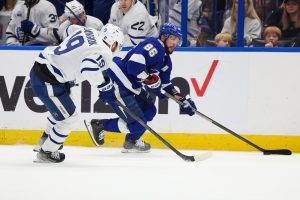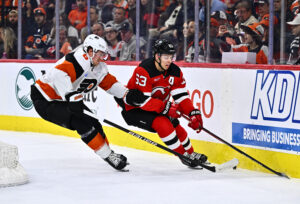Marian Hossa signing as a free agent with the Chicago Blackhawks on July 1st, 2009 was a momentous achievement by former general manager Dale Tallon. Unfortunately for Tallon, the Marian Hossa contract signing would be one his last official acts for the team. He was relieved from his duties less than two weeks later in a move many skeptics called “heartless”.
Marian Hossa‘s Contract = Blackhawks Renaissance
As general manager, Tallon had guided the Blackhawks out of some incredibly rough times for the original six franchise. The team drafted Jonathan Toews third overall in the 2006 NHL draft. That elite pick was followed by the Blackhawks winning the draft lottery and selecting Patrick Kane first overall in 2007. The Blackhawks had two legitimate superstars in the making.
By the summer of 2009, the Blackhawks were a team on the cusp of greatness. All they needed was another top-six winger to put them over the top and compete for the Stanley Cup. That’s where Marian Hossa came into play. He had signed two straight one year deals with the Pittsburgh Penguins and Detroit Red Wings. When free agency opened July 1st, 2009, rumours of him becoming a Blackhawk were finalized.
The Deal
Marian Hossa was by far one of the most sought-after free agents for three straight summers. The Blackhawks and Tallon knew they had to lock up Hossa for life with a long-term “front-end loaded” deal. The Blackhawks offered the 30-year-old Hossa a 12-year contract valued at $63 million in total. The contract was huge, but with “averaging” only amounted to a reasonable salary cap hit of $5.275 million per season.
Year By Year
Here’s the annual salary breakdown of the contract signed by Marian Hossa in real dollars:
- 2009-10 = $7.9 million
- 2010-11 = $7.9 million
- 2011-12 = $7.9 million
- 2012-13 = $7.9 million
- 2013-14 = $7.9 million
- 2014-15 = $7.9 million
- 2015-16 = $7.9 million
- 2016-17 = $4 million
- 2017-18 = $1 million
- 2018-19 = $1 million
- 2019-20 = $1 million
- 2020-21 = $1 million
Contract Expectations
As you can see, the contract pays very little in the last four years as Hossa reaches his 40’s. It was assumed by many that Hossa would be nearing retirement at some point before the 12 years ended. Especially after Hossa and the Blackhawks won three Stanley Cups in 2010, 2013, and 2015. He had played a ton of games over the course of his career and was a key to three Stanley Cups.
There isn’t much else a player in his late 30’s could ask for, right? Expectations were that Hossa would ride off into the sunset. He would be revered as one of the best two-way players to ever suit up. He could leave the game in his prime, a three-time Stanley Cup Champion. There isn’t a better ending for a career by NHL standards.
Contract Reality
While winning three Stanley Cups, the Blackhawks also rewarded several of their core with “Blackhawk For Life” contracts. They signed Duncan Keith to a long-term deal with an annual cap hit of $5,538,462 for 2010 through 2023. Patrick Kane and Jonathan Toews signed monster twin contracts after the last Cup in 2015. They each signed eight-year deals with an annual cap hit of $10.5 million for 2015 through 2023. Brent Seabrook also signed an eight-year deal with an annual cap hit of $6.785 million for 2016 through 2024.
Adding Marian Hossa‘s cap hit of $5.275 million brings the total to nearly $39 million a year for only five players on the roster. Having over half of your annual salary cap invested in five players will hamstring any franchise and prevent them from making moves. This has been clear the last several years as general manager Stan Bowman made many moves to relieve cap space. Bowman has walked this cap tightrope and been successful until the last couple of seasons.
Compete Level
The team has declined the last couple of seasons due to their core ageing as well as several Bowman roster moves that sent several productive players away to relieve their yearly cap problems. This was no more evident than last season as the Blackhawks failed to make the playoffs for the first time since 2006-07.
Team Needs
This off-season the Blackhawks and their fans were hoping that the annual NHL Draft and free agency would provide some solutions for the team’s ability to compete in the tough Western Conference. The Blackhawks had a great draft, but fans expected some prospects who could help “the now, not the future.” Then free agency opened on July 1st, and the Blackhawks signed three players that enraged fans on social media who were unimpressed. Fans everywhere were in a tizzy. Many did not understand Bowman’s signings and what they meant for the team’s ability to compete.
The Hossa Factor
The Blackhawks entered free agency with a little over $9 million in cap space, which did not include Hossa’s contract of $5.275 million. With Hossa being unable to play last year, the team used the long-term injured reserve (LTIR) clause to get cap relief once the 2017-18 season began. After the season, Marian Hossa chose to walk away from hockey for good. Hossa did not officially retire keeping his salary on the books, but avoiding the cap re-capture penalties that came in the 2013 Collective Bargaining Agreement.
The team was faced with tough choices. They could try to trade Hossa’s contract to a team that needed to get to the NHL salary cap floor. They could also place Hossa on LTIR again once the season began, which would give cap relief for trade deadline moves but not free agents this summer.
LTIR Questions
The ability for a team to use the LTIR is a given. Most believe that the team does not get cap relief during the off-season. This is why fans were only told that the Blackhawks had $9 million plus in cap space available instead of nearly $15 million factoring in the Hossa contract. In reality, NHL teams do have LTIR cap relief during the off-season. This was proven last season by the Toronto Maple Leafs.
The previous use of LTIR by the Leafs has bordered on creative “Shenanigan’s” to say the least. Check this out from Arvind from S.B. Nation:
So, James Mirtle of The Athletic dropped a bit of a bomb on everyone on Tuesday afternoon, when he wrote an article arguing that the Leafs are not actually up against the cap. His argument is that LTIR can be used in the offseason, and he quotes NHL Deputy Commissioner Bill Daly as evidence.
“Yes, they can,” Daly said when asked if teams were permitted to access additional cap room in this fashion long before the season started. “Same as in-season.”
Salary Cap LTIR Education
For a complete and thorough education on LTIR and its effect on the salary cap check this out from CapFriendly.com :
“Can LTIR be used in the off-season?”
“Yes, LTIR can be used in the off-season while the 10% off-season cushion is active. LTIR in the off-season is calculated using the basic equation outlined above, which permits a team to exceed the off-season salary cap. To use off-season LTIR the team must provide doctors proof that the player in question will continue to be injured at the beginning of the regular season for 10 NHL games and 24 calendar days.”
“At the start of the season the teams LTIR relief & ACSL is recalculated when the 10% cushion is removed.”
Cap Hit Or No Cap Hit?
This discovery actually creates more questions than answers for Blackhawk fans. If the LTIR provides cap relief during the off-season, why wasn’t this something used when Stan Bowman was signing free agents? Another $5 million plus may have altered the players signed, to say the least. Would Blackhawks fans still be in an uproar if Bowman had signed a top-tier free agent? Maybe, but that is what winning three Stanley Cups in six seasons can do to a fan base. Blackhawk fans expect a Cup run every year, not a rebuild as the team’s core ages.
Future Cap Concerns Ahead
The smart money is that Stan Bowman is preparing for the near future when his younger players will need to be taken care of financially. At the end of 2018-19, there will be numerous players becoming restricted free agents. (RFA’s) These include budding stars Dylan Sikura, Nick Schmaltz, Blake Hillman, Victor Ejdsell, Gustav Forsling, and potential goalie of the future Collin Delia.
This list does not include proven star Alex DeBrincat who led the team in goals last season. DeBrincat becomes an RFA at the end of 2020-21. Vinnie Hinostroza is another key player becoming an RFA at the same time as DeBrincat. You see where this is heading?
Planning and More Planning
Stan Bowman has another major roster problem on the horizon. He will need every spare dollar he can use to lock up the young players. These players will potentially make up the future core of the team very soon and must be taken care of to secure a competitive team going forward. It’s not easy for fans to see past the present where their favourite team did not make the playoffs. They need patience but do however have the right to expect the rebuild to be successful sooner than later as the current core ages. We’ll see what Bowman has in store for the team.
Main Photo:






